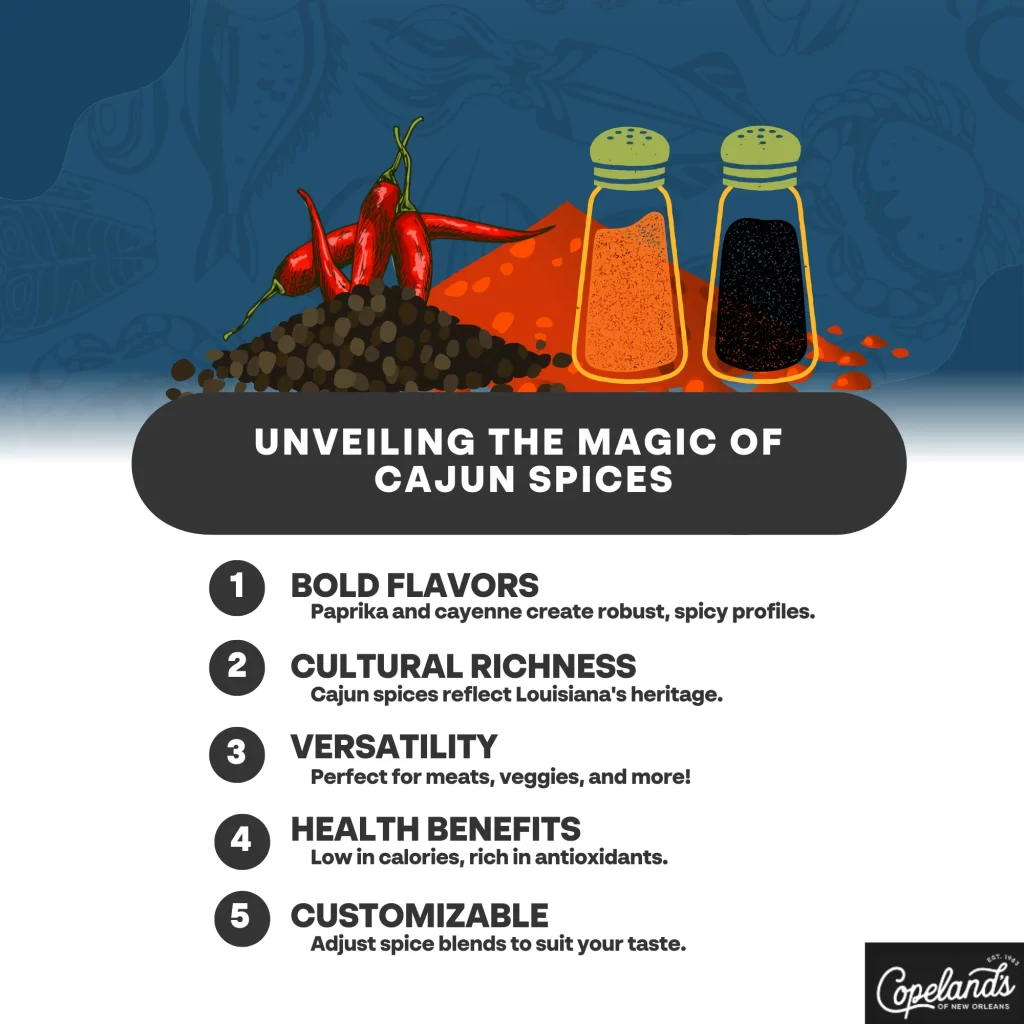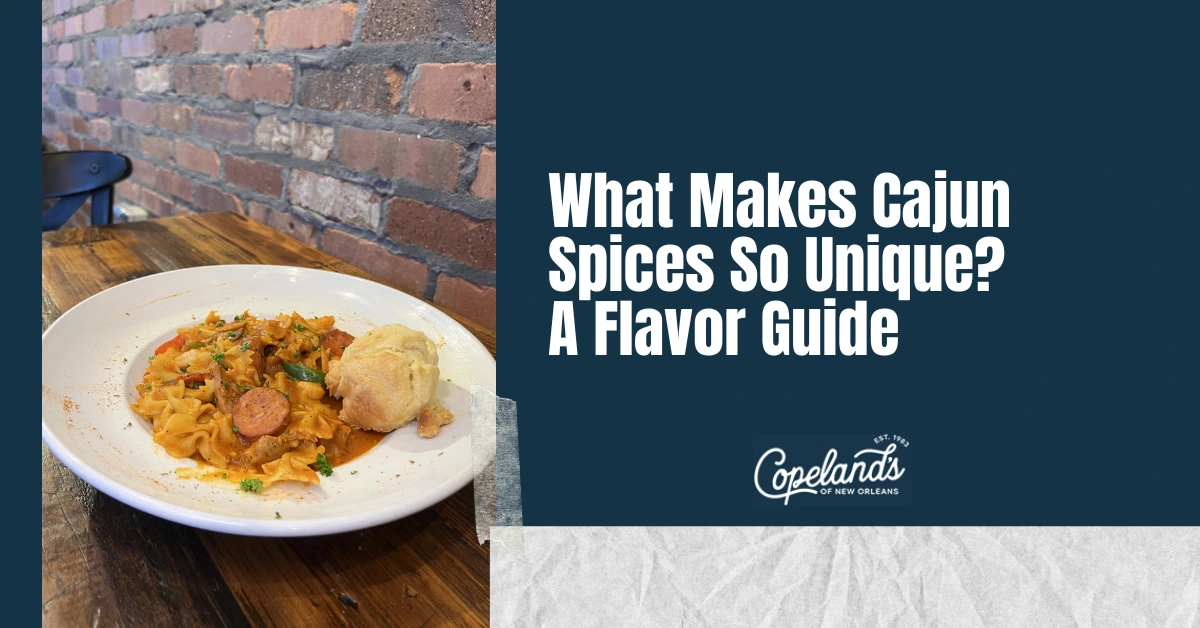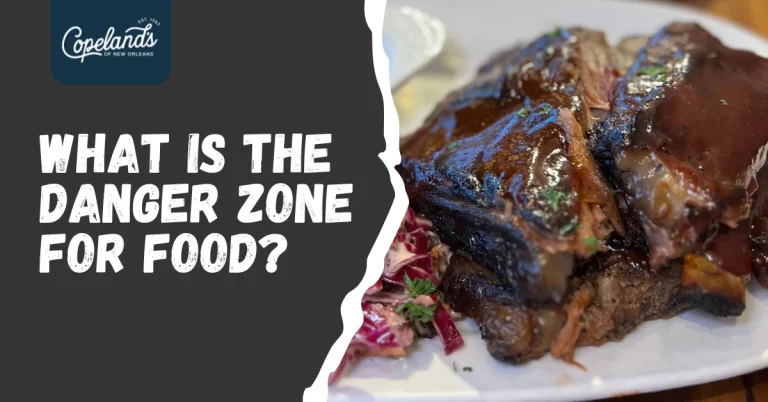Cajun spices are unique because they marry bold flavors with a rich cultural history. Originating from the Acadian settlers in Louisiana, these spices are a vibrant blend of paprika, cayenne pepper, garlic, and herbs like oregano and thyme. This combination offers a smoky base with a kick of heat, creating complex layers of sweet, savory, and spicy. Cajun seasoning lifts everything from meats to vegetables, turning ordinary dishes into something extraordinary. If you’re curious about how to harness their full potential or create your own blends, there’s even more to explore.

Key Takeaways
- Cajun spices blend bold flavors from ingredients like paprika, cayenne pepper, garlic, and onion, creating a robust and complex flavor profile.
- The unique combination of spices enriches the umami taste, making dishes like gumbo and jambalaya memorable and flavorful.
- Cajun cuisine’s rustic roots contribute to its straightforward use of spices, emphasizing hearty and communal dining experiences.
- Rich in antioxidants and low in calories, Cajun spices promote healthier cooking without sacrificing taste or depth of flavor.
- The versatility of Cajun spices allows them to elevate various dishes, from meats to vegetables, making them essential in everyday cooking.
An Extremely Brief History of the Cajuns (aka “Acadians”)
When you think of Cajun culture, it’s hard not to appreciate its rich history, rooted in the story of the Acadians. The Acadians were French settlers who established their homes in Canada’s Maritime provinces. However, in the mid-18th century, they faced deportation from the British, leading many to seek refuge in Louisiana. This migration marked the beginnings of what we now call Cajun culture.
Cajun spice origin is intertwined with the Acadian story. As they settled in the bayous and swamps, they adapted their culinary practices, blending French traditions with local ingredients and spices.
So, what are Cajun spices? They typically include a mix of paprika, cayenne pepper, garlic powder, onion powder, and black pepper. This distinctive blend reflects the Acadians’ resourcefulness, utilizing whatever was available to create bold flavors that pack a punch.
The rich tapestry of Cajun history and its fusion of cultures not only shaped their identity but also laid the groundwork for the unique spices that flavor their cuisine today. Understanding this background amplifies your appreciation of the vibrant flavors that define Cajun cooking.
The Rise of Cajun Cuisine
As the Acadians settled in Louisiana, their culinary practices began to flourish, leading to the rise of Cajun cuisine. This vibrant culinary tradition is a melting pot of flavors, influenced by the region’s rich history and diverse cultures. Cajun dishes showcase the boldness of cajun spices, which include paprika, cayenne pepper, garlic powder, onion powder, and black pepper. These spices create a depth of flavor that’s both savory and spicy, making every bite an adventure.
Cajun cuisine is all about using what’s available, transforming humble ingredients into mouthwatering meals. You might encounter classic dishes like gumbo, jambalaya, and étouffée, all bursting with the unmistakable flavors of Cajun seasoning. Each dish tells a story of resourcefulness and creativity, reflecting the spirit of the Cajun people.
The rise of Cajun cuisine also stems from its communal nature, bringing friends and family together around the table. As you explore this culinary world, you’ll appreciate how these unique flavors connect people and celebrate the rich heritage of Louisiana. Immerse yourself in the experience, and let the magic of Cajun spices awaken your taste buds!
Cajun vs. Creole: Similar But Not The Same
Cajun and Creole cuisines often get lumped together, but they have distinct origins and characteristics that set them apart. Cajun cuisine hails from the French-speaking Acadian settlers in Louisiana, embracing rustic, earthy flavors and hearty, simple dishes.
In contrast, Creole cuisine reflects a blend of cultural influences, including Spanish, African, and Native American, resulting in more refined and elaborate dishes.
When it comes to spices, a Cajun spices list typically includes paprika, cayenne pepper, garlic powder, onion powder, and black pepper. These spices create a bold, robust flavor profile that defines Cajun dishes like jambalaya and gumbo. t The spices that make up Cajun seasoning, are a blend that gives Cajun food its signature kick.
Creole seasoning, on the other hand, often incorporates herbs like thyme and oregano, along with the same base spices found in Cajun blends. This results in a more complex and layered flavor, suitable for dishes like shrimp Creole or red beans and rice.
Understanding these differences not only elevates your culinary experience but also deepens your appreciation for the vibrant cultures behind these delicious cuisines.
What is Cajun Seasoning?
Understanding the nuances of Cajun and Creole cuisines sets the stage for appreciating the unique elements of Cajun seasoning. At its core, Cajun seasoning is a robust blend designed to elevate your dishes with a burst of flavor. You might wonder what spices make Cajun seasoning so distinctive. Typically, it includes a combination of paprika, cayenne pepper, garlic powder, onion powder, and black pepper. These spices in Cajun seasoning create a well-rounded profile that’s both spicy and savory.
The beauty of Cajun seasoning lies in its versatility. You can sprinkle it on meats, seafood, vegetables, or even use it to kick up the flavor of soups and stews. It’s not just about heat; the smoked paprika adds a rich, earthy undertone, while garlic and onion powder provide aromatic depth.
What truly sets Cajun seasoning apart is its ability to transform everyday dishes into something extraordinary. Whether you’re making a classic jambalaya or simply grilling chicken, a dash of this seasoning can transport your taste buds straight to the heart of Louisiana. So, get ready to embrace the bold, vibrant flavors that Cajun seasoning brings to your culinary adventures!
What Does Cajun Flavor Taste Like?
When you take a bite of a dish seasoned with Cajun spices, a symphony of flavors dances on your palate, blending heat, smokiness, and a hint of sweetness. The magic lies in the combination of spices that create a unique profile. You’ll often find paprika, cayenne pepper, garlic powder, onion powder, and black pepper in a traditional Cajun spices recipe. Each ingredient contributes to that signature taste, with paprika adding a gentle warmth and color, while cayenne delivers a bold kick.
As you savor the dish, the smokiness of the spices becomes apparent, evoking the deep-rooted traditions of Cajun cooking. This smoky essence, often complemented by the inclusion of herbs like oregano and thyme, transports you to the heart of Louisiana. You may also notice a slight sweetness, which comes from the caramelization of onions or bell peppers in many Cajun recipes.
How to Make Cajun Seasoning
Creating your own Cajun seasoning at home is a simple yet rewarding process that allows you to tailor the flavors to your taste. To start, gather your cajun seasoning spices: paprika, cayenne pepper, garlic powder, onion powder, dried thyme, dried oregano, and black pepper. You can adjust the amounts based on how spicy or aromatic you prefer your blend.
In a mixing bowl, combine two tablespoons of paprika with one tablespoon each of cayenne pepper, garlic powder, and onion powder. Then, add one teaspoon each of dried thyme, dried oregano, and black pepper. This combination will give you a classic cajun spice blend recipe that’s versatile and packed with flavor.
Once mixed, taste your seasoning and tweak it if necessary. Want more heat? Add a bit more cayenne. Prefer a smokier flavor? Increase the paprika. Store your homemade Cajun seasoning in an airtight container, and it’ll last for months, ready to spice up any dish you desire. With your custom blend in hand, you’ll be well-equipped to bring that delicious Cajun flair to your kitchen!
Cajun Seasoning Recipes
Cajun seasoning recipes often elevate a variety of dishes, bringing a burst of flavor that’s hard to resist. These recipes showcase the robust spices used in Cajun cooking, which include paprika, cayenne pepper, garlic powder, and onion powder. Originating from the vibrant culture of Louisiana, Cajun seasoning reflects a blend of French, Spanish, and African influences.
One of the simplest ways to incorporate Cajun seasoning is by using it as a dry rub on chicken or fish. Just mix the seasoning with a bit of olive oil and coat your protein before grilling or roasting. It’s a surefire way to infuse flavor into your meal!
Another fantastic recipe is Cajun shrimp pasta. Sauté shrimp with a generous amount of Cajun spices, garlic, and bell peppers, then toss it all with your favorite pasta and a creamy sauce. The heat from the spices perfectly complements the richness of the dish.
For a hearty side, try Cajun-style roasted vegetables. Toss seasonal veggies with olive oil and Cajun seasoning before roasting them to caramelized perfection. Trust me, these recipes will make you appreciate where Cajun seasoning comes from and the delicious flavors it can bring to your kitchen!
Frequently Asked Questions
What Are the Most Common Ingredients in Cajun Seasoning?
Common ingredients in Cajun seasoning include paprika, cayenne pepper, garlic powder, onion powder, black pepper, and thyme. These spices create a bold, flavorful blend that elevates any dish you prepare. Enjoy cooking!
How Does Cajun Cuisine Differ From Southern Cooking?
Cajun cuisine’s bold flavors and reliance on local ingredients set it apart from Southern cooking. These include spicier dishes, a focus on rustic preparations, and a unique blend of French, Spanish, and African influences to create unforgettable meals.
Can Cajun Spices Be Used in Non-Cajun Dishes?
Absolutely, you can use Cajun spices in non-Cajun dishes! They add a bold kick to everything from grilled vegetables to pasta. Just sprinkle a little, and you’ll elevate your flavors with that signature zest.
Are There Vegetarian Options for Cajun Cooking?
You can swap meats for flavorful veggies, beans, or tofu, creating delicious dishes that still capture that vibrant, zesty Cajun spirit you love.
How Can I Adjust Cajun Seasoning for Different Spice Levels?
You can easily adjust Cajun seasoning by adding more paprika for sweetness, cayenne for heat, or garlic powder for depth. Start with small increments, tasting as you go, until you achieve your desired spice level.
Conclusion
Cajun spices are more than just a blend; they’re a vibrant reflection of a rich cultural history. Did you know that over 90% of Louisiana’s population claims Cajun ancestry? This statistic highlights the deep-rooted connection between the people and their culinary traditions. By embracing the bold flavors of Cajun seasoning, you’re not just elevating your dishes; you’re savoring a legacy that’s as colorful as the spices themselves. So, get cooking and let those flavors tell their story!




